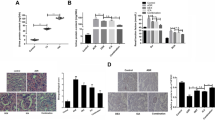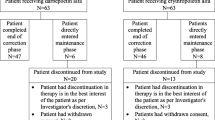Abstract
Objectives
To study the effects of darbepoetin-α (DPO-α) (erythropoietin analog) on adriamycin (ADR)-induced chronic nephropathy in rats.
Methods
Sixty-nine male Sprague-Dawley rats divided into 3 groups (23 rats each): negative control group: normal rats received saline as a vehicle; positive control (ADR) group: rats received 2 iv injection of ADR via penile vein at 14-day interval without treatment; and DPO-α group: as ADR group but rats received sc DPO-α (0.3 μg/kg bw) once weekly for 12 weeks. By the end of experiment hemoglobin (Hb) content, serum creatinine, BUN, albumin, triglycerides and cholesterol, urinary protein excretion and kidney injury molecule-1 (KIM-1). GSH, malondialdehyde, caspase-3 expression histopathological and electron microscopic examinations for kidney tissues were done.
Results
DPO-α significantly improved the animal survival rate and body weight, Hb, serum BUN, triglycerides, cholesterol, and albumin and urinary protein excretion and KIM-1 in urine. Also, administration of DPO-α improved the morphological damage in glomeruli and renal tubules as well as caspase-3 expression and markers of oxidative stress in kidney tissues.
Conclusion
Administration of DPO-α alleviates ADR nephropathy and this might due to improvement of Hb content, hyperlipidemia, enhancement of endogenous antioxidants, reduction of apoptosis and tubulointerstitial injury and maintaining the integrity of glomerular membrane.






Similar content being viewed by others
References
Lerman LO, Chade AR (2009) Angiogenesis in the kidney: a new therapeutic target. Curr Opin Nephrol Hypertens 18(2):160–165
Lee VW, Harris DC (2011) Adriamycin nephropathy: a model of focal segmental glomerulosclerosis. Nephrology 16:30–38
Okuda S, Oh Y, Tsuruda H et al (1986) Adriamycin-induced nephropathy as a model of chronic progressive glomerular disease. Kidney Int 29(2):502–510
Chen A, Sheu LF, Ho YS et al (1998) Experimental focal segmental glomerulosclerosis in mice. Nephron 78:440–452
Pippin JW, Brinkkoetter PT, Cormack-Aboud FC et al (2009) Inducible rodent models of acquired podocyte diseases. Am J Physiol Renal Physiol 296:F213–F229
Liu LL, Li QX, Xia L, Li J, Shao L (2007) Differential effects of dihydropyridine calcium antagonists on doxorubicin-induced nephrotoxicity in rats. Toxicol 231(1):81–90
El-Shitany NA, El-Haggar S, El-Desoky K (2008) Silymarin prevents adriamycin-induced cardiomyopathy and nephropathy in rats. Food Chem Toxicol 46:2422–2428
Johnson DW, Vesey DA, Gobe GC (2010) Erythropoietin protects against acute kidney injury and failure. Open Drug Discov J 2(1):8–17
Vesey DA, Cheung C, Pat B et al (2004) Erythropoietin protects against ischaemic acute renal injury. Nephrol Dial Transplant 19:348–355
Aydin Z, Duijs J, Bajema IM et al (2007) Erythropoietin, progenitors, and repair. Kidney Int Suppl 107(Suppl):16–20
Egrie JC, Dwyer E, Browne JK et al (2003) Darbepoetin alfa has a longer circulating half-life and greater in vivo potency than recombinant human erythropoietin. Exp Hematol 31(4):290–299
Bahlmann FH, Fliser D (2009) Erythropoietin and renoprotection. Curr Opin Nephrol Hypertens 18(1):15–20
Duan WR, Garner DS, Williams SD et al (2003) Comparison of immunohistochemistry for activated caspase-3 and cleaved cytokeratin 18 with the TUNEL method for quantification of apoptosis in histological sections of PC-3 subcutaneous xenografts. J Pathol 199:221–228
Hayat MA (2000) Chemical fixation. In: Hayat MA (ed) Principles and techniques of electron microscopy: biological applications, 4th edn. Cambridge University Press, Cambridge
Quiles JL, Ochoa JJ, Huertas JR et al (2006) Olive oil and mitochondrial oxidative stress: studies on adriamycin toxicity, physical exercise and ageing. In: Quiles JL, Ramirez-Tortosa MC, Yaqoob P (eds) Olive oil and health. CABI Publishing, Oxford, pp 119–151
Granados-Principal S, Quiles JL, Ramirez-Tortosa CL et al (2010) New advances in molecular mechanisms and the prevention of adriamycin toxicity by antioxidant nutrients. Food Chem Toxicol 48(6):1425–1438
Ammar HI, Saba S, Ammar RI et al (2011) Erythropoietin protects against doxorubicin-induced heart failure. Am J Physiol Heart Circ Physiol 301(6):2413–2421
Boonsanit D, Kanchanapangka S, Buranakarl C (2006) L-carnitine ameliorates doxorubicin-induced nephrotic syndrome in rats. Nephrology 11(4):313–320
Liu HF, Guo LQ, Huang YY et al (2010) Thiazolidinedione attenuate proteinuria and glomerulosclerosis in adriamycin-induced nephropathy rats via slit diaphragm protection. Nephrol 15(1):75–83
Magnasco A, Corselli M, Bertelli R et al (2008) Mesenchymal stem cells protective effect in adriamycin model of nephropathy. Cell Transplant 17(10–11):1157–1167
Hong YM, Kim HS, Yoon H (2002) Serum lipid and fatty acid profiles in adriamycin-treated rats after administration of L-carnitine. Pediatr Res 51:249–255
Pries AR, Secomb TW, Gaehtgens P (2000) The endothelial surface layer. Pflug Arch Eur J Physiol 440(5):653–666
Drumond MC, Deen WM (1994) Structural determinants of glomerular hydraulic permeability. Am J Physiol 266(1):1–12
Jeansson M, Bjorck K, Tenstad O, Haraldsson B (2009) Adriamycin alters glomerular endothelium to induce proteinuria. J Am Soc Nephrol 20:114–122
Yang W, Wang J, Shi L et al (2012) Podocyte injury and overexpression of vascular endothelial growth factor and transforming growth factor-beta 1 in adriamycin-induced nephropathy in rats. Cytokine 59:370–376
Tesar V, Zima T, Jirsa M Jr et al (2002) Influence of losartan and enalapril on urinary excretion of 8-isoprostane in experimental nephrotic syndrome. Med Sci Monit 8(2):69–74
Eddy AA (1989) Interstitial nephritis induced by protein-overload proteinuria. Am J Pathol 135:719–733
Vaidya VS, Ramirez V, Ichimura T et al (2006) Urinary kidney injury molecule-1: a sensitive quantitative biomarker for early detection of kidney tubular injury. Am J Physiol Renal Physiol 290:517–529
Van Timmeren MM, Bakker SJ, Vaidya VS et al (2006) Tubular kidney injury molecule-1 in protein-overload nephropathy. Am J Physiol Renal Physiol 291(2):456–464
Bahlmann FH, Song R, Boehm SM et al (2004) Low-dose therapy with the long-acting erythropoietin analogue darbepoetin alpha persistently activates endothelial Akt and attenuates progressive organ failure. Circulation 110:1006–1012
Fliser D, Bahlmann FH, Haller H (2006) EPO: renoprotection beyond anemia correction. Pediatr Nephrol 21(12):1785–1789
Eto N, Wada T, Inagi R et al (2007) Podocyte protection by darbepoetin: preservation of the cytoskeleton and nephrin expression. Kidney Int 72:455–463
Genc S, Akhisaroglu M, Kuralay F, Genc K (2002) Erythropoietin restores glutathione peroxidase activity in 1-methyl-4-phenyl-1,2,5,6- tetrahydropyridine induced neurotoxicity in C57BL mice and stimulates murine astroglial glutathione peroxidase production in vitro. Neurosci Lett 321:73–76
Katavetin P, Inagi R, Miyata T et al (2007) Erythropoietin induces heme oxygenase-1 expression and attenuates oxidative stress. Biochem Biophys Res Commun 359(4):928–934
Kasap B, Soylu A, Kuralay F et al (2008) Protective effect of Epo on oxidative renal injury in rats with cyclosporine nephrotoxicity. Pediatr Nephrol 23(11):1991–1999
Johnson DW, Forman C, Vesey DA (2006) Novel renoprotective actions of erythropoietin: new uses for an old hormone. Nephrology 11:306–312
Lacombe C, Mayeux P (1998) Biology of erythropoietin. Haematologica 83:724–732
Kashii Y, Uchida M, Kirito K et al (2000) A member of Forkhead family transcription factor, FKHRL1, is one of the downstream molecules of phosphatidylinositol 3-kinase-Akt activation pathway in erythropoietin signal transduction. Blood 96(3):941–949
Acknowledgments
We acknowledge Dr Azza El Hadidy, professor of Histology and Cell Biology, Mansoura Faculty of Medicine for her help in histopathological examination.
Author information
Authors and Affiliations
Corresponding author
Ethics declarations
Conflict of interest
None.
Ethical approval
All applicable international, national, and/or institutional guidelines for the care and use of animals were followed.
Rights and permissions
About this article
Cite this article
Hussein, A.M., Eldosoky, M., Handhle, A. et al. Effects of long-acting erythropoietin analog darbepoetin-α on adriamycin-induced chronic nephropathy. Int Urol Nephrol 48, 287–297 (2016). https://doi.org/10.1007/s11255-015-1171-1
Received:
Accepted:
Published:
Issue Date:
DOI: https://doi.org/10.1007/s11255-015-1171-1




